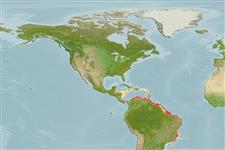Scomberomorus brasiliensis Collette, Russo & Zavala-Camin, 1978
Serra Spanish mackerel
把你的觀察加入 Fish Watcher
| Native range | All suitable habitat | Point map | Year 2050 |

|
| This map was computer-generated and has not yet been reviewed. |
| Scomberomorus brasiliensis AquaMaps Data sources: GBIF OBIS |
上傳你的 相片 和 影像
Pictures | Google 影像Scomberomorus brasiliensis
Picture by Duarte, L.O.
Pictures | Google 影像Scomberomorus brasiliensis
Picture by Duarte, L.O.
Common names from other countries
分類 / Names 俗名 | 同種異名 | Catalog of Fishes(屬, 種) | ITIS | CoL | WoRMS | Cloffa
Teleostei > Scombriformes (Mackerels) 鱸形目 (Mackerels) > Scombridae (Mackerels, tunas, bonitos) 鯖科 (Mackerels, tunas, bonitos) > Scombrinae
Etymology: Scomberomorus: Latin, scomber = mackerel + Greek, moros = silly, stupid (Ref. 45335).
Etymology: Scomberomorus: Latin, scomber = mackerel + Greek, moros = silly, stupid (Ref. 45335).
Environment: milieu / climate zone / depth range / distribution range 生態學
分布 國家 | FAO區域 | 生態系 | 發現紀錄 | Point map | 簡介 | Faunafri
Western Atlantic: along the Caribbean and Atlantic coasts of Central and South America from Belize to Rio Grande do Sul, Brazil. Literature records for Scomberomorus maculatus from the Caribbean and the Atlantic coasts of Central and South America apply to Scomberomorus brasiliensis, which has erroneously been considered a synonym of Scomberomorus maculatus by many authors.
西大西洋: 沿著對 Rio Grande do Sul 巴西的中美洲與南美洲從貝里斯的加勒比海與大西洋海岸。 給 Scomberomorus maculatus 從加勒比海與中美洲與南美洲的大西洋海岸的文獻記錄適用於 Scomberomorus brasiliensis, 已經錯誤地被許多作家被認為是一個 Scomberomorus maculatus 的同種異名。
西大西洋: 沿著對 Rio Grande do Sul 巴西的中美洲與南美洲從貝里斯的加勒比海與大西洋海岸。 給 Scomberomorus maculatus 從加勒比海與中美洲與南美洲的大西洋海岸的文獻記錄適用於 Scomberomorus brasiliensis, 已經錯誤地被許多作家被認為是一個 Scomberomorus maculatus 的同種異名。
Length at first maturity / 大小 / 重量 / 年齡
Maturity: Lm 37.0 range ? - ? cm
Max length : 125 cm FL 雄魚/尚未辨別雌雄; (Ref. 168); common length : 65.0 cm TL 雄魚/尚未辨別雌雄; (Ref. 9987); 最大體重: 6.7 kg (Ref. 40637)
Max length : 125 cm FL 雄魚/尚未辨別雌雄; (Ref. 168); common length : 65.0 cm TL 雄魚/尚未辨別雌雄; (Ref. 9987); 最大體重: 6.7 kg (Ref. 40637)
簡短描述 檢索表 | 型態特徵 | 形態測量圖
背棘 (總數) : 17 - 19; 背的軟條 (總數) : 15 - 19; 臀棘: 2; 臀鰭軟條: 16 - 20; 脊椎骨: 47 - 49. Snout much shorter than rest of the head. Interpelvic process short and bifid. Lateral line gradually curving down toward caudal peduncle. Body entirely covered with small scales, no anterior corselet developed. Pelvic fins relatively short. Intestine with 2 folds and 3 limbs. Swim bladder absent. Sides silvery with several rows of round yellowish bronze spots. First dorsal fin black.
吻遠短於其餘的頭部。 腹鰭間的突起短與兩裂的。 側線逐漸地對於尾柄彎曲下來。 身體完全地覆蓋著小鱗片了,沒有前面的甲胄發展。 腹鰭相當短的。 腸道有 2 摺層與 3 肢翼。 泳鰾不存在。 側邊銀色的有圓淡黃色的青銅色的斑點的幾排。 第一背鰭黑色。
吻遠短於其餘的頭部。 腹鰭間的突起短與兩裂的。 側線逐漸地對於尾柄彎曲下來。 身體完全地覆蓋著小鱗片了,沒有前面的甲胄發展。 腹鰭相當短的。 腸道有 2 摺層與 3 肢翼。 泳鰾不存在。 側邊銀色的有圓淡黃色的青銅色的斑點的幾排。 第一背鰭黑色。
Does not migrate extensively, although some seasonal movement appears to occur off Trinidad. Feeds largely on fishes, with smaller quantities of penaeid shrimps and loliginid cephalopods. Most of the catch is consumed fresh, but in Brazil some is salted and some has been canned. Also utilized smoked and frozen; used for ceviche (Ref. 9987).
不會廣泛地移動, 雖然一些季節性的運動似乎出現外海的千里達。 主要地吃魚,與少量的對蝦與槍魷魚科頭足類動物。 大部分的捕捉被生鮮消費,但是在巴西一些是鹽醃而一些已經被裝於罐頭。 也利用煙燻而且凍結; 用來了 ceviche 。 (參考文獻 9987)
不會廣泛地移動, 雖然一些季節性的運動似乎出現外海的千里達。 主要地吃魚,與少量的對蝦與槍魷魚科頭足類動物。 大部分的捕捉被生鮮消費,但是在巴西一些是鹽醃而一些已經被裝於罐頭。 也利用煙燻而且凍結; 用來了 ceviche 。 (參考文獻 9987)
Life cycle and mating behavior 成熟度 | 繁殖 | 產卵場 | 卵 | 孕卵數 | 仔魚
西大西洋: 沿著對 Rio Grande do Sul 巴西的中美洲與南美洲從貝里斯的加勒比海與大西洋海岸。 給 Scomberomorus maculatus 從加勒比海與中美洲與南美洲的大西洋海岸的文獻記錄適用於 Scomberomorus brasiliensis, 已經錯誤地被許多作家被認為是一個 Scomberomorus maculatus 的同種異名。
主要參考資料
Upload your references | 參考文獻 | 合作者 : Collette, Bruce B. | 合作者
Collette, B.B. and C.E. Nauen, 1983. FAO Species Catalogue. Vol. 2. Scombrids of the world. An annotated and illustrated catalogue of tunas, mackerels, bonitos and related species known to date. Rome: FAO. FAO Fish. Synop. 125(2):137 p. (Ref. 168)
對人類具威脅
無害處的
人類使用
漁業: 商業性; 游釣魚種: 是的
FAO(漁業: 產生; publication : search) | FIRMS (Stock assessments) | FishSource | 周邊海洋
更多資訊
Population dynamics
成長參數
Max. ages / sizes
Length-weight rel.
Length-length rel.
長度-頻率
Mass conversion
入添量
豐度
成長參數
Max. ages / sizes
Length-weight rel.
Length-length rel.
長度-頻率
Mass conversion
入添量
豐度
Anatomy
鰓區
Brain
Otolith
鰓區
Brain
Otolith
Physiology
Body composition
Nutrients
耗氧量
游泳類型
游泳速度
Visual pigments
Fish sound
Diseases & Parasites
Toxicity (LC50s)
Body composition
Nutrients
耗氧量
游泳類型
游泳速度
Visual pigments
Fish sound
Diseases & Parasites
Toxicity (LC50s)
Genetics
遺傳學
Heterozygosity
遺傳率
遺傳學
Heterozygosity
遺傳率
工具
E-book | 野外調查 | 檢索表 | 長度- 頻率 Wizard | 生活- 歷史的工具 | 分布圖 | Classification Tree
| Catch-MSY |
特別的報告
下載 XML
網路資源
Aquatic Commons | BHL | Cloffa | Websites from users | 檢查 FishWatcher | CISTI | Catalog of Fishes(屬, 種) | DiscoverLife | ECOTOX | Faunafri | Fishtrace | GenBank(基因組, 核甘) | GloBI | GOBASE | | Google Books | Google Scholar | Google | IGFA World Record | MitoFish | 國家資料庫 | Otolith Atlas of Taiwan Fishes | PubMed | Reef Life Survey | Scirus | SeaLifeBase | 樹狀分類階層 | Wikipedia(去, 搜尋) | World Records Freshwater Fishing | Zoobank | 動物學的記錄
Estimates based on models
Preferred temperature (Ref. 115969): 24.9 - 28, mean 27.5 (based on 176 cells).
Phylogenetic diversity index (Ref. 82804): PD50 = 0.5000 [Uniqueness, from 0.5 = low to 2.0 = high].
Bayesian length-weight: a=0.00776 (0.00481 - 0.01252), b=2.97 (2.84 - 3.10), in cm Total Length, based on LWR estimates for this species & Genus-body shape (Ref. 93245).
營養階層 (Ref. 69278): 3.3 ±0.4 se; based on diet studies.
回復力 (Ref. 120179): 中等的, 族群倍增時間最少 1.4 - 4.4年 (K=0.18; tm=3-4).
Prior r = 0.56, 95% CL = 0.37 - 0.84, Based on 2 data-limited stock assessments.
Fishing Vulnerability (Ref. 59153): High to very high vulnerability (67 of 100).
Climate Vulnerability (Ref. 125649): High to very high vulnerability (75 of 100).




